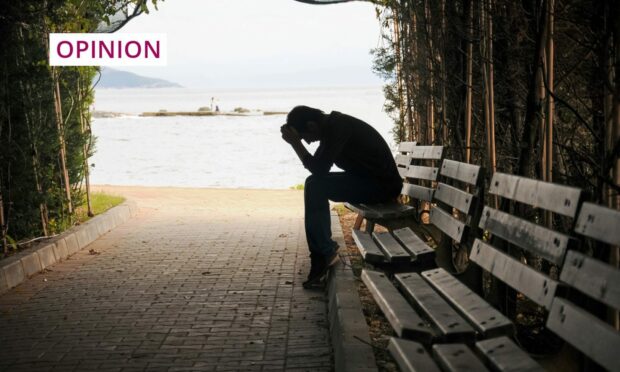I was an anxious child. From the off, I found it hard to cope with other people and everyday situations.
I was a shaky, moody little thing. For a time, I made repeated, involuntary noises, little squeaks that horribly embarrassed me but that I could do nothing to stop.
I was an anxious teen, too. I struggled to pass exams because I couldn’t study – my concentration was shot and so I couldn’t retain information. I played football at a reasonably high level but would spend much of each match distractedly counting my teeth with my tongue. I had 29, I knew, but I had to check, over and over again.
And I’ve been an anxious adult, living for periods under a black cloud of dread. Over the years, this has affected my health in all sorts of ways: psychological problems, stomach cramps, muscular pains. I’ve taken time off work. I’ve skipped important dinners and events. I’ve self-medicated. I’ve sat through what should have been engaging and useful meetings with interesting people while desperately wanting to bolt for the door.
I’ve seen psychologists and psychiatrists and been prescribed this and that drug, some of which proved more effective than others. Often, the first challenge of each morning has been to wrestle my personal demons to the ground. I felt like I was starting the day two drinks behind everyone else.
Here’s the thing: we may not be a species of squeakers and teeth-counters exactly, but nor do I think I’m particularly unusual or strange. In conversations with medical experts, I’ve learned just how common conditions such as anxiety, depression and OCD really are. They affect many, many people across the full spectrum of society, including – perhaps especially – those regarded as high performers: hospital consultants, lawyers, government ministers, celebrities.
Among my friends, I can count the number I would describe as well-adjusted on one hand. The internet truism is based in fact: everyone is fighting a battle you know nothing about.
NHS is not set up to cope with current mental health crisis
If anything, recent reports suggest that mental health problems are on the rise. The Office for National Statistics says that one in four of us have “high” levels of anxiety. A quarter of the 2.5 million adults currently out of the jobs market due to long-term sickness have anxiety, depression or similar conditions, up nearly 100,000 since 2019.
A new survey of 2,000 people has found that more than half of those aged between 16 and 24 have taken time off in the past six months due to stress, anxiety and depression. A third of workers in the 45 to 54 age group have done the same.
There are some obvious causes for this trend. Lockdown had its enjoyable moments, but it has also left a legacy of social estrangement and altered habits – this is perhaps most obvious in our schools, where teachers report pupils are unable to focus, are more disruptive and are more likely to be absent. Social media, its daily practises of hostility and judgment, adds a new level of pressure, particularly on young girls.
The cost-of-living crisis is straining most families, with many of life’s ameliorating pleasures sacrificed in order to afford essentials such as higher food and heating bills as well as increased mortgage payments.
No wonder people are wilting, and that more of us are taking anti-anxiety medicine and anti-depressants than at any time in history. But the NHS is not set up to cope with this crisis. Across the UK, adult mental health services are heavily over-subscribed and under-resourced. Although the workforce increased by 22% overall between 2016-17 and 2021-22, patient referrals rose by 44%. Staff vacancy rates in acute inpatient mental health services are around 20%.
In Scotland, a Scottish Government pledge to eradicate waiting lists for CAMHS, the children’s mental health service, by March this year fell well short. Only 75% of patients were seen within 18 weeks of referral, despite a target of 90%. Nearly 500 children had been waiting for treatment for more than a year. Many parents are taking their kids to private clinics of varying quality for diagnosis and care – the wellness industry, some of it based on proper research, some of it on unscientific juju, is booming.
Can’t we do better?
What to do? It would be useful if the NHS could devote more resources to mental health, but it faces spending pressures across the board. There is no spare money, and so any additional funding would mean stripping cash from other priorities.
The workplace is improving. It has certainly changed since I began my career. The newspaper offices in which I started out were harsh, sink-or-swim environments with lots of shouting and plenty drinking. By the time I left my last full-time post, there was yoga, massage and a counsellor available in the building. Perhaps working from home will have a further positive impact, with people more trusted to manage their workflows.
It still took until well into my 40s before I found any kind of peace with myself
I’m much better these days, but I largely put this down to the rub of time. Getting older, gaining greater experience of situations that once intimidated, the realisation that the worst rarely happens, have all sanded down the sharper edges of my anxiety.
But it still took until well into my 40s before I found any kind of peace with myself. As a society, we can surely do better than that.
Chris Deerin is a leading journalist and commentator who heads independent, non-party think tank, Reform Scotland











